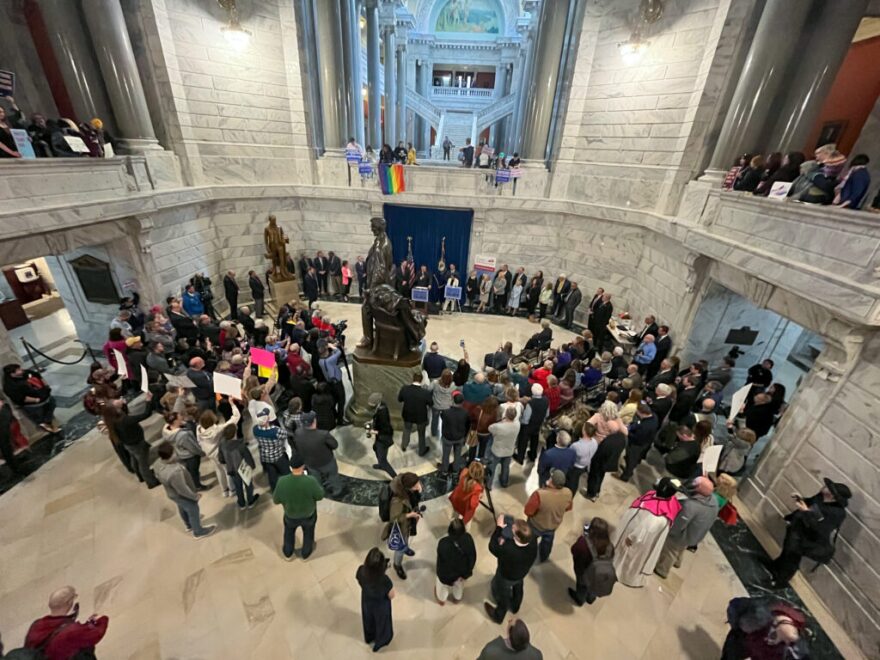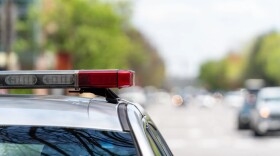The Kentucky General Assembly plans to convene in temporary chambers for at least the next three years while the Capitol undergoes extensive renovations.
During those years, there will be no public galleries where citizens can watch as the House and Senate debate and vote on new laws.
No rotunda where advocates and protesters can gather for rallies.
And less opportunity for citizens and lobbyists to personally interact with lawmakers in the halls.
People will be able to watch the legislature in session in real time from next door in the Capitol Annex via live streams of the proceedings.
But the setup leaves some Frankfort regulars concerned.
Amye Bensenhaver, co-director of the Kentucky Open Government Coalition, said that without a space for the public to observe in person, the legislature risks violating the state Open Meetings Act.
A Senate Republican spokesperson rejected any suggestion that the temporary arrangement violates open government laws. He said the expense of building a gallery in a temporary building could not be justified and would have been “an irresponsible use of taxpayer dollars.”
Becky Jones, vice president of the League of Women Voters’ Kentucky chapter, said the League understands the cost concerns but would like to see more proactive steps to ensure public access to the legislative process.
“I think the League certainly appreciates the cost constraints that the legislature faced when building the temporary structure that’s going to service for three more years,” Jones recently told the Kentucky Lantern. “We also appreciate that the loss of a public viewing gallery is not insignificant, and I think there could have been more definitive steps taken to ensure that we will have access via this live stream.”
“The chambers are for the people, not merely the legislators,” Jones said.
The state’s public broadcast network, KET, will still have cameras in the House and Senate chambers to carry the live stream, but Congress recently voted for significant cuts to public media funding nationwide.
Physical presence and participation
The Senate’s Republican leaders last month unveiled the Senate side of the temporary building. Senate President Robert Stivers took reporters on a tour of the space, showing offices and conference rooms down the hall from the temporary Senate floor.
Asked about the absence of a public gallery, Stivers cited cost. The Capitol galleries overlook the floors of the House and Senate and are entered by their own stairs.
“I think what the discussion was, we could have built the gallery, but you think about expensive — this is already expensive,” Stivers said of the $14 million structure where the legislature plans to hold at at least three regular sessions. The Capitol renovation is expected to cost almost $300 million.

Republican Caucus Chair Robby Mills, of Henderson, said during the press conference that “public access is still going to be 100% to the process” with KET streaming.
Reporters will still be allowed in the chamber as well.
Finance and Administration Cabinet spokesperson Kinsey Woodson told the Lantern in an email that “the General Assembly never requested a design option with a public gallery space, and therefore no estimate was ever made.”
Bensenhaver, a former Kentucky assistant attorney general who authored open records and open meetings decisions for 25 years, said Stivers’ comments during the press conference sounded “really dismissive of what his predecessors in office considered a priority.”
In 2013, the General Assembly codified that public agencies must “provide meeting room conditions, including adequate space, seating, and acoustics, which insofar as is feasible allow effective public observation of the public meetings.” Later that same year, lawmakers added to state law that for any public meeting, agencies “shall evaluate space requirements, seating capacity, and acoustics.”
“There’s a physical presence that I think is so important to public participation — this idea that by the strength of your numbers, you show support or opposition to an idea or a proposal,” Bensenhaver said.
Jones had similar thoughts. When people are allowed in a gallery space, they might see how lawmakers off camera react to debate on the floor, and that might open an opportunity to approach the lawmaker and ask about their reaction.
“When you’re observing what’s going on the floor, it’s like you’re watching a play,” Jones said. “ You can see things that happen that aren’t going to necessarily be provided by a livestream, because we have to depend on the person running the camera and how many cameras are set up.”
Dustin Isaacs, a spokesperson for the Senate majority caucus, said in a statement to the Lantern that the temporary setup does not violate the Open Meeting Act. “Claims to the contrary ignore both the plain language of the statute and common sense.”

“The law requires public meetings to be observable ‘insofar as is feasible.’ The Kentucky Attorney General affirmed that standard during the pandemic (OAG 20-05), recognizing that under extraordinary circumstances, physical accommodations may be adjusted, as long as the public can still observe proceedings effectively. A full Capitol renovation, planned with input from both the legislative and executive branches, clearly qualifies. Constructing a second-story gallery in a temporary chamber is not just impractical; it is structurally, logistically, and financially infeasible and would be an irresponsible use of taxpayer dollars.”
Isaacs added that those who’ve engaged with lawmakers on this issue “will hopefully recognize we’ve been responsive and have focused on delivering accessible solutions despite challenging circumstances beyond our control.” He reiterated the addition of viewing rooms with the livestreams in the annex, maintaining press access and “continued online transparency,” arguing these “tools not only meet the law’s requirements for public observation, but arguably exceed them.”
While lawmakers understand that some would prefer the option of in-person gallery seating, but some have suggested that not having the gallery is because of lawmakers’ contempt for public transparency, which is “not only inaccurate, it’s hyperbolic and revisionist,” Isaacs said.
“The gallery isn’t meant to be a venue for protest or spectacle. It has always been a place for quiet observation, not disruption,” he said.
Isaacs compared expecting the temporary building to fully replicate the permanent chambers in the Capitol to “insisting all public communication be hand-delivered or printed when a website goes down.” During the renovation, legislative information and meetings will be accessible to the public.
Isaacs added that lawmakers have “acted in good faith and within the law.”
“Recasting a temporary logistical challenge as a constitutional crisis does not reflect a commitment to transparency,” he said. “It demonstrates a commitment to political theater.”
Changes to advocacy?
The extensive renovation also means that the Capitol rotunda is closed. The space, centrally located between the House and Senate and in front of the governor’s office, was often used for press conferences and rallies by outside groups.
No similar central space is part of the temporary legislative quarters. But Democratic Gov. Andy Beshear said in a July 10 press conference that his administration was working on an alternative space for groups to use and hold rallies, “maybe not as large as could have been in the Capitol rotunda.”
“We recognize that’s needed, and we’re working on that which is within our control,” he said.

Kate Miller, the ACLU of Kentucky’s advocacy director, told the Lantern that “it’s too early to know what the impact will be on constituents being able to engage their lawmakers” during the renovation. Most of the ACLU’s advocacy efforts took place in lawmakers’ annex offices by connecting constituents with members of the legislature.
Mike Harmon, director of state outreach for the Commonwealth Policy Center, said in an email that the rotunda would be missed. He also touted the effectiveness of building individual relationships with lawmakers.
The advocates who most influenced him when he was in the House “were those who were sincere in what they believed and were not afraid to answer the question, ‘who is for it and who is against it?’” It didn’t mean those advocates “always got what they asked for, but I did consider those types of conversations with greater weight,” the former state auditor added.
“True advocacy comes from developing relationships and not becoming angry when an issue you want doesn’t pan out that session. There is always another session and another issue that you want to advocate for with legislators,” Harmon said, predicting that the Commonwealth Policy Center’s development of such relationships will make up for the loss of personal access in the temporary building. “I would imagine the negative impact to our efforts should be minimal.”
Jones of the League said that during the renovation “people might be drawn to find different ways to make their presence known.” That might look like silent protests or being outside the temporary structure. It could also look like being more present in committee meetings and preparing statements to give during hearings.
“I think it’s hard to predict how advocacy will change,” Jones said. “I think it will change. I’m just not sure how that’s going to happen.”
This article was originally published by the Kentucky Lantern.





